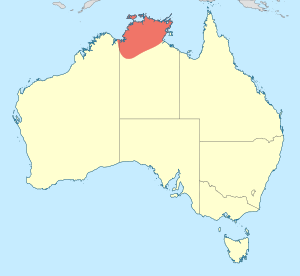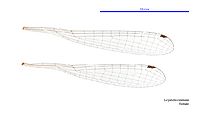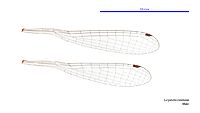Eurysticta coomalie facts for kids
Quick facts for kids Coomalie pin |
|
|---|---|
| Conservation status | |
| Scientific classification | |
 |
The Coomalie pin (scientific name: Eurysticta coomalie) is a type of damselfly. It belongs to the family Isostictidae. This special insect is found only in the northern part of the Northern Territory in Australia. It loves to live near streams and pools of water.
Coomalie pins are small to medium-sized damselflies. They are usually pale brown with a shiny bronze-green color.
Contents
What is a Damselfly?
Damselflies are fascinating insects that look a lot like dragonflies. They are part of a group called Odonata. One easy way to tell a damselfly from a dragonfly is by how they hold their wings when resting. Damselflies usually hold their wings together over their back, while dragonflies hold theirs out to the sides.
Where Coomalie Pins Live
The Coomalie pin is an endemic species. This means it lives naturally in only one specific place in the world. For the Coomalie pin, that place is the northern area of Australia's Northern Territory. They prefer habitats with fresh water, like slow-moving streams and calm pools. These watery places are important for them to lay their eggs and for their young to grow.
What They Look Like
The Coomalie pin is a pretty insect. It has a slender body, which is typical for damselflies. Its main colors are a light brown and a metallic bronze-green. This coloring helps them blend in with the plants and water around their habitat. Like all damselflies, they have two pairs of clear wings and large eyes that help them spot their prey.
Life Cycle of a Damselfly
Damselflies, including the Coomalie pin, have an interesting life cycle that involves living in water for part of their lives.
From Egg to Nymph
The life of a Coomalie pin starts when the female lays her eggs in or near water. These eggs hatch into young forms called nymphs. Damselfly nymphs live underwater. They are often camouflaged, meaning they blend in with their surroundings to avoid predators. Nymphs breathe using special gills at the end of their bodies.
Growing Up Underwater
As nymphs, Coomalie pins spend their time hunting small aquatic creatures. They grow by shedding their skin several times, a process called molting. This stage can last for weeks or even months, depending on the species and conditions.
Emerging as an Adult
When a nymph is ready to become an adult, it crawls out of the water, usually onto a plant stem or rock. Its skin then splits open, and the adult damselfly emerges. At first, the adult's wings are soft and crumpled, but they quickly expand and harden. Once their wings are ready, the adult Coomalie pin can fly.
What Coomalie Pins Eat
Adult Coomalie pins are predators. They mostly eat small flying insects, like mosquitoes and gnats. They are very good at catching their prey in mid-air using their strong legs. This makes them helpful insects because they control populations of other small insects.
Conservation Status
The Coomalie pin is currently listed as "Least Concern" (LC) by the IUCN Red List. This means that, for now, its population is stable and it is not considered to be at high risk of extinction. However, it's always important to protect their freshwater habitats to ensure they continue to thrive.
Gallery




